Recommended Varieties/Cultivars
GardenZeus recommends cucumber varieties that tolerate heat and temperature extremes for most of California.
Slicing cucumbers:
Poinsett 76 is a favorite open-pollinated, heat-tolerant, flavorful variety that is also disease-resistant (including mildews). Marketmore 76 is a classic favorite for its long harvest period, reliable fruit production under moderate environmental stress, and resistance to mildews.
Straight Eight is a reliable and much-beloved heirloom that produces fruits with a rich cucumber flavor.
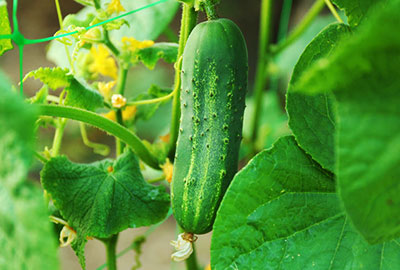
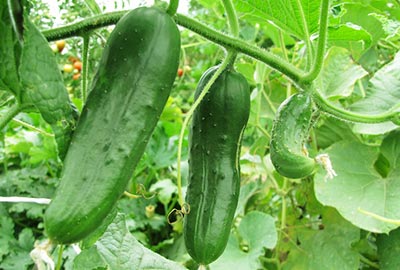
The Chinese heirloom Suyo Long is mild-flavored, burpless, early, and heat-tolerant. Fruits grow up to 15 inches and tend to curl if not grown vertically. Summer Dance is a prolific and heat-tolerant Japanese-type hybrid that is resistant to mildews.
Beit Alpha is a Middle Eastern heat-tolerant heirloom. If you've had trouble with heirloom cucumbers producing during hot spring weather, try the hybrid Olympic.
Pickling cucumbers:
Homemade Pickles is a compact, vining, highly productive variety that can also be eaten fresh. Spacemaster is a heat-tolerant, prolific producer of full-sized slicing cucumbers on a compact plant with vines to 3 feet; fruits can be pickled when harvested small.
For a vigorous, productive, full-sized vining pickler, try Burpee Pickler hybrid.
Harvest starts early at 48 days for Persian Baby, a compact, prolific, parthenocarpic variety that is harvested small for fresh eating or pickling.
Novelty Cucumbers:
Lemon is a round, ball-shaped yellow heirloom that is delicious both for slicing and pickling, and is easy to digest. It tolerates less-frequent watering during cool weather and stores longer than most varieties. White Wonder is a heat-tolerant 1893 heirloom that produces unique, ivory-colored fruits for slicing or pickling.
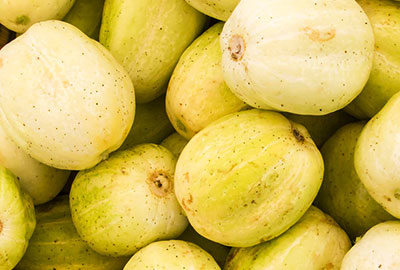
For information about the different types of garden cucumbers, see these articles in our special series "Getting to Know Cucumbers:"
Part 1: Two Basic Cucumber Decisions: Slicers Versus Picklers, and Vining Versus Bush Types
Part 2: Cucumber Characteristics and Terminology
Part 3: A Guide to Cucumber Types
Buying/Selection Tips
Purchase seeds, not seedlings. Cucumbers should generally be seeded directly outdoors. GardenZeus recommends against purchasing cucumber starts for transplant, especially if rootbound or it has been more than about 2 weeks since germination, as starts may be prone to slow establishment, poor yield, diseases, pests, and other problems.
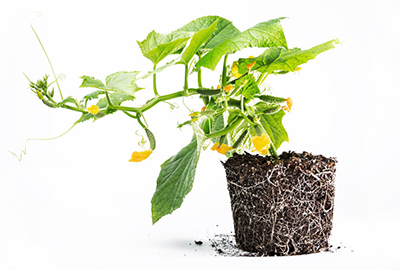
For tips and information about purchasing vegetable seedlings, see : The GardenZeus Guide to Buying Vegetable Seedlings.
Soil Needs/Tip
Cucumbers are heavy feeders that benefit from well-drained, loose, fertile soil with moderate-to-high organic matter. Avoid growing any cucumber varieties in the same place for more than one season at a time to avoid depleting soil and concentrating pest populations and diseases.
See GardenZeus Alert: Beware of Heavy Feeders! for precautions about successive planting of vegetables that may deplete your soil.
As long as fertility and drainage are sufficient, most cucumbers perform reasonably well in a variety of soils. Cucumbers are less fussy than some vegetables about soil acidity, and perform well in the range of about 5.8 to 6.9 pH.
Cucumbers often grow slowly, produce little yield, become chlorotic, and may be prone to pests and diseases if planted in new, uncultivated, infertile, or compacted soils.
Suitable Microclimate
Cucumbers need full sun at cool-to-warm temperatures and fertile soil that is consistently moist but not wet. They do well during cool weather in raised beds with southern and western exposures.
Ideal temperature range for germination is 70° to 95°F with fastest germination at the warmer end of this range. Ideal temperature range for growth and fruiting is about 65° to 75°F. Most cucumber varieties tolerate warmer temperatures up to 90°F for short periods of up to a few days at a time, but growth and fruiting may be diminished at temperatures above 85°F. Cucumbers tend to produce a higher ratio of male flowers at high temperatures, and/or flowers may drop, which can reduce yield. Quality and flavor of most cucumber varieties are directly affected at high temperatures. Some heat-tolerant varieties grow and fruit reasonably well at temperatures above 85°F. See "Recommended Varieties/Cultivars" above for detailed information.
Most cucumber varieties are extremely tender and cold sensitive. Generally they will be harmed or killed by frost. Many varieties grow slowly or not at all at temperatures below 55°F. Plants may become stressed and fruit quality diminish during periods of cool weather below 50°F.
Cucumbers will benefit from shade during hot weather. See GardenZeus Tips for Shading Vegetables During Hot Weather for creative ideas from expert Darren Butler about providing shade.
Getting Started
Cucumbers have a reputation for being easy to grow, but GardenZeus expert Darren Butler has found that this is not always so in California's dry Mediterranean climate. Cucumbers prefer a narrow temperature range of about 55° to 85°F for growing and fruiting. In many California areas there is no 60-day growing that reliably accommodates this. See "Seasonal Care" in the GardenZeus section "Seasonal and Harvesting" below for tips and detailed discussion about when to plant cucumbers.
When considering which cucumber varieties to grow, start by deciding between slicers for eating fresh or picklers, or choose variety(s) that that can be used for both. Bush plants are often highly productive proportionately in small growing spaces, but vining varieties usually produce a greater overall yield if you have the available space.
Cucumbers are among the most difficult vegetables to predict yield from number of plants, especially when seasonal conditions aren't suited to their needs. They are sensitive to soil fertility, watering, temperature, and other environmental conditions. The right number of plants one year may produce too few or too many cucumbers in a warmer or cooler year. Harvest period and yield also vary significantly among different varieties. Under ideal growing conditions, vigorous heirlooms and hybrids may produce dozens of fruits per plant, but 6 to 12 fruits per plant is a more reasonable expectation in challenging California growing conditions for most open-pollinated varieties.
In reasonably good soil, about 4 to 6 plants per person should produce enough slicers for ample fresh eating, with the assumption included that some plants will underperform due to heat, cold, pests, or other stressors. Stagger plantings about every 2 weeks during your growing season.
For canning and pickling, an entire crop is usually planted and harvested all at once. For many California areas, 3 to 5 plants per quart of pickles is a reasonable estimate, again with the expectation of some degree of underperformance. Some hybrid and heirloom picklers are much more productive than others.
See "Planting Method/Tips" in the GardenZeus section "Planting and Maintaining" for tips about getting started with cucumbers.
Watering Tips
Cucumber plants benefit from consistently moist-but-not-wet. They are among the most-sensitive vegetables to moisture extremes in soil. They suffer and become highly stressed in dry soils, and are also prone to diseases in wet soils or if overwatered. Seeds may rot if kept overly wet when germinating. Avoid watering with sprinklers. Leaves of cucumber plants should be kept entirely dry as much as possible.
Cucumber roots tend to be shallow in the heavy, clay, and compacted soils that are common in your zone. Plants may need more-frequent watering than other cucurbits. In loose soils, cucumbers grow a taproot that may extend to 2 feet or more in depth, with the majority of roots generally remaining in the top 12 inches of soil.
Sufficient and even watering is especially important for cucumbers while they are flowering and fruiting. Water-stress while fruiting may increase bitterness of cucumber fruits.
See The GardenZeus Guide to Watering Cucumbers, Melons, and Squash (Cucurbits) for tips and more information about watering cucumbers.
Planting Method/Tips
Plant pre-germinated seeds (not transplants) or seed cucumbers directly outdoors when frost risk is low and daytime temperatures are consistently 65°F and above. Cucumber starts are extremely tender and may harmed or killed by frost.
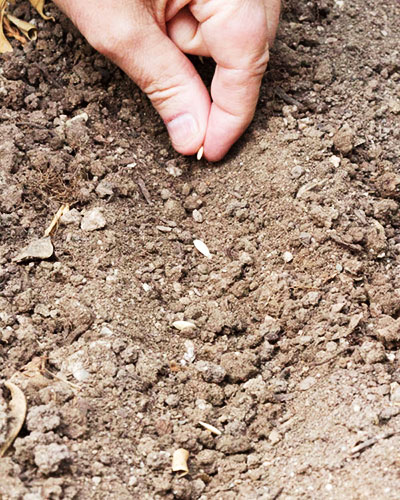
See Growing Cucumbers in the California Home Garden for tips and information about growing cucumbers.
See "Seasonal Care" in the GardenZeus section "Seasonal and Harvesting" below for tips and detailed discussion about when to plant cucumbers.
Spacing
Cucumber spacing depends upon variety, planting style, and available garden space. Cucumbers are traditionally planted with 2 to 4 seeds per planting hole or mound, then thinned to one plant per hole, spaced about 1 to 4 feet apart for compact and bush varieties; and 3 to 5 feet or more apart for vining varieties. Plant seeds about 1/2-to-1 inch deep.
When grown in rows, plant bush varieties about 4 to 8 inches apart in rows 2 to 4 feet apart. Thin plants to one every 1 to 4 feet, depending upon variety. Vining varieties can be seeded about 4 to 12 inches apart, with final spacing of about 3 to 5 feet or more apart in rows that are about 3 to 6 feet apart, depending on variety.
For plants grown on trellises or around wire cages or baskets, thin to final spacing of about 1 to 3 feet apart, depending upon variety.
Timelines
3 to 10 days or longer to seed germination. Generally, cucumbers should germinate within a week if kept moist at temperatures of 70° to 95°F.
Transplanting is possible about 10 to 18 days after germination but recommended only for skilled biointensive gardeners and experienced gardeners who are willing to monitor seedlings closely.
10 to 21 days after germination to 1st thinning.
Thin to final spacing by about 3 to 4 weeks after germination, possibly longer during cool weather or for slow-growing plants.
50 to 75 days for slicers, sometimes longer, from germination to harvest depending on variety and growing conditions; or as few as 45 days for baby slicers.
45 to 70 days for picklers, sometimes longer, from germination to harvest depending on variety and growing conditions; or as few as 40 days for baby picklers.
Harvest Period: In fertile soil during cool weather, with proper care and frequent harvest, depending on variety and growing conditions, slicers may remain productive for 1 to 4 months. Picklers are often harvested all at once or over a period of a few weeks, but if kept harvested they may continue to produce for up to a few months.
Pollination Needs/Tips
Cucumbers are monoecious, meaning that a single plant produces both male and female flowers. Pollination is critical for most cucumber varieties to produce fruit.
It is normal for the first round of blooms to fall off a cucumber plant. Early cucumber flowers are usually all male; no fruits will form from these flowers. If flowers continue falling off without forming fruit, or established plants drop female flowers and fail to form fruit, lack of pollination is usually the cause.
Male and female cucumber flowers are easily recognized with close observation. Male flowers tend to be on longer stems, grow in clusters, and have only a stem at the base of the flower, while female flowers grow singly and have a tiny immature fruit, which technically is the ovary, between the base of the flower and a shorter stem. Gardeners often assume the wrong gender for cucumber blooms. As GardenZeus expert Darren Butler has bravely clarified many times over the years, with cucumber blooms, unlike with humans, the flower with the tube is the girl.
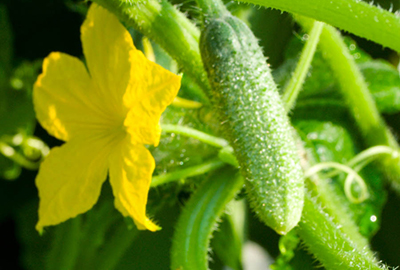
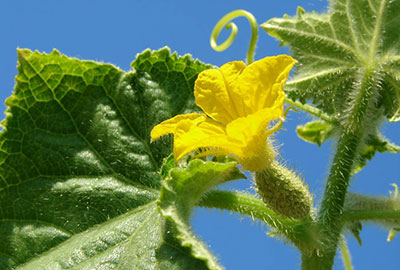
If pollinators are still not abundant in your garden, pollinate cucumber plants by hand. Use a small paintbrush to transfer pollen, or pick male flowers and rub the stamens onto the pistils of female flowers.
If you've had low yields as a result of poor pollination, try parthenocarpic varieties that produce fruit without pollination. See "Recommended Varieties/Cultivars" in the GardenZeus section "Getting Started," above.
Long distances between different cucumber varieties or isolation is required to save seeds that remain true-to-variety across multiple plant generations. Saving cucumber seeds in the home garden generally requires tying off female flowers before they open with a stocking, paper bag, or other "hood;" removing coverings once blooms are open to pollinate by hand; then tying off the pollinated blooms again to avoid further pollination by insects. If saving seeds, allow fruits to remain on the vine until they grow to full size and harden. When the stem attached to a mature cucumber fruit is brown and dead, this usually a means that seeds are ready to harvest.
Gynoecious cucumber varieties produce mostly female flowers, with a small or almost nonexistent proportion of male flowers. If pollinated adequately, they produce more fruit per plant than standard varieties.
Interplanting/Companion Planting
Because lack of pollination is a primary reason for poor yield, GardenZeus recommends encouraging bees to visit your cucumbers by planting them near borage, nasturtiums, rosemary, oregano, and other heat-tolerant, bee-attracting herbs and plants. Traditional lore suggests that close planting with some of the aromatic herbs in the list above and others including sage in particular, may adversely affect cucumbers, including the taste of fruits. This is unproven by research and GardenZeus expert Darren Butler has never found it to be an issue.
Allowing vegetables like radishes and carrots to flower and persist in your garden may also attract bees and help with cucumber pollination. Timing the flowering of radishes is tricky at best. During warm weather, planting radishes 30 days or so before planting cucumbers in the same area may both help discourage cucumber beetles and time radish flowering for approximately the time that cucumbers will be in bloom.
Avoid planting root crops, such as beets, onions, and potatoes near cucumbers, which may disturb sensitive cucumber roots when harvested.
With the long vines and sprawling habit of many varieties, cucumbers may overwhelm smaller plants and shade them out with large leaves. Cucumbers can be successfully grown with tall or large columnar plants, such as sunflowers and amaranth.
Traditional companions for cucumbers include corn, dill, marigolds, nasturtiums, and sunflowers. Cucumbers are considered a deterrent to raccoons and are sometimes planted near corn for this reason, but GardenZeus expert Darren Butler considers this an unwise combination partly because corn can be a strong attractor for cucumber beetles, but also simply because not much will stop a hungry raccoon short of a big aggressive dog or two.
Nutrient/Amendment/Fertilization Needs/Tips
Cucumbers are heavy feeders. A soil test is recommended to determine nutrient levels prior to applying fertilizer.
Work compost, composted manures, or well-rotted organic matter into soils before planting, and maintain nutrient-rich surface dressings under mulch. Bury plugs of finished compost or worm compost a few inches outside of the driplines of established plants 2 or 3 times per growing season and water thoroughly. For soils low in calcium, crush or grind up eggshells and add to the soil surface under mulch at the base of each plant. Grow cucumbers or other cucurbits only once every 2 to 4 years in a given bed or garden area to allow the soil to recover between plantings.
GardenZeus recommends adding nitrogen in the form of diluted urea or a cup of chicken manure diluted in 4 gallons of water (half cup if fresh manure) and mixed thoroughly, after seedlings are a few to several inches tall and about once or twice per month thereafter. Adding too much nitrogen may result in rapid growth and lush, high-carbohydrate leaves that attract insect infestation; and slowed or reduced yields.
Reduce or discontinue fertilizing with nitrogen several weeks before the arrival of hot weather to avoid producing large, lush leaves that will tend to wilt and cause stress to cucumber plants during summer heat.
Fish emulsion or seaweed extracts applied as drenches or foliar spray may be beneficial in soils that are infertile, alkaline, or lacking micronutrients.
Mulching
Mulching cucumber plants is particularly important, especially during warm-to-hot weather, to maintain even soil moisture, cool soils during hot weather, and inhibit weeds to avoid root disturbance to cucumbers from weeding. Use a half-inch of fine mulch for small starts under 4 inches in height; increase to 1 to 3 inches or more of fine to medium mulch after plants are 6 to 12 inches tall.
During cool weather, mulch may encourage low soil temperatures that slow growth of cucumber plants. It may improve cucumber growth to minimize or avoid using mulch until weather has warmed to consistently above 65°F.
Straw and/or pine needles make good mulches for cucumbers. Having plenty of mulch around unsupported vining cucumbers is a benefit when plants begin fruiting. Mulch can be mounded here and there as necessary to support cucumber fruits and prevent them from resting on damp soil, which encourages prematurely rotted fruit.
Pruning/Cutting Back/Pinching/Separating
Cucumber plants may be pruned for many specific reasons, including improving yield during a short timeframe or at the end of a growing season, or for intensive growing such as in a greenhouse or small growing space. For most gardeners growing cucumbers outdoors, there is no need to prune cucumbers, and doing so may encourage pests or diseases and shorten harvest period.
Cucumbers grown on trellises, other support, or in containers may need pruning to keep them manageable or train them into a specific growing space. This involves selectively pinching, shortening, or removing lateral or horizontal stems, and any other growth that becomes problematic in the space available. Dead leaves or stems can be removed from cucumber plants at anytime. Damaged, diseased, or rotting cucumber fruits should be removed promptly to limit spread of disease, conserve plant resources for healthy fruits, and encourage new fruiting.
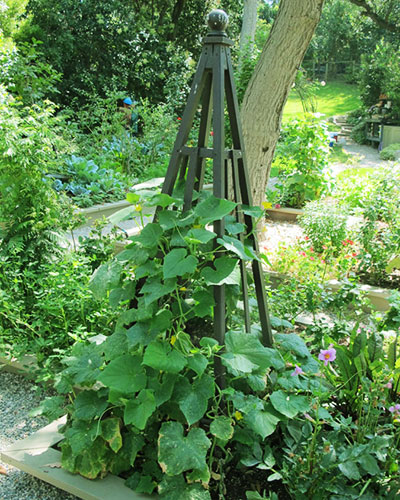
GardenZeus generally does not recommend cutting back or removing cucumber leaves or stems unless you have a specific and necessary reason for doing so. One exception is judicious thinning of leaves if plants wilt persistently during hot weather despite having ample soil water.
For more information see The GardenZeus Guide to Watering Cucumbers, Melons, and Squash (Cucurbits)
Propagating
From seed. GardenZeus recommends open-pollinated, untreated, organically grown seeds.
Container Gardening
Most bush varieties and smaller vining cucumber varieties do well in containers. Use well-drained containers that are at least 12 to 16 inches wide and deep; larger is generally better. A trellis or structure for climbing may help vining varieties to remain manageable, receive enough sunlight, and yield well in containers.
Spacemaster produces compact vines to 3 feet; fruits can be pickled small but also grown to full-sized slicers. Lemon cucumber can be grown in containers with support. Homemade Pickles is a compact, vining, highly productive variety that can also be eaten fresh. Persian Baby is a compact, prolific producer of small cucumbers for fresh eating or pickling.
Hybrid cucumbers for containers:
Salad Bush hybrid is a prolific, disease-resistant AAS winner that produces full-sized slicers on small bush plants. Fresh Pickles hybrid is an early, compact vining variety producing attractive plants and fruits suited to fresh eating or pickling. Picklebush is a productive, mildew-resistent bush hybrid pickler, with attractive white/green fruits.
For more details about some of these varieties, see "Recommended Varieties/Cultivars" in the GardenZeus section "Getting Started."
Plant 2 to 3 cucumber seeds per container and thin to 1 plant when seedlings are 2 to 4 inches tall. Very large containers may support more than one cucumber plant. Soil tends to dry out more frequently in containers or raised beds, so be sure to monitor as needed and provide sufficient and consistent water.
See GardenZeus Tips for Container Vegetable Gardening for general information and tips about growing vegetables and herbs in containers.
Seasonal Care
Cucumbers are a warm-season crop because they're frost sensitive, but they are also sensitive to heat. They grow and fruit best in full sun at temperatures from 55° to 85°F, with optimal growing temperature between 65° and 75°F. In addition to being prone to stress at temperatures above about 85°F, many varieties are also sensitive to temperatures below about 50°F and may be damaged by periods of temperatures in the 40s or below.
In many areas of California, there is no reliable annual growing window of 60 to 70 days when temperatures stay within the range of 55° to 85°F, so row covers or other methods to protect plants from both heat and frost are often necessary for worthwhile yields.
Seed cucumbers or plant pre-germinated seeds directly outdoors when frost risk is low and daytime temperatures are consistently 65°F and above. Stagger new plantings about every 2 weeks. Varieties that tolerate heat and temperature extremes do best warm-summer areas.
Use row covers, or improvised materials such as cloth sheets or cardboard, overnight to protect plants from frosts and cold temperatures. Remove covers during the day for sunlight and to allow pollination by insects.
As cucumber plants mature, particularly during hot weather, they may be infested by leafminers and other insects. Leaves may be covered in mildew, chlorotic, or bug-eaten. Plants often continue to produce mature fruits and produce a yield despite looking ragged and unhealthy.
Cucumbers will benefit from shade during hot weather. See GardenZeus Tips for Shading Vegetables During Hot Weather for creative ideas from expert Darren Butler about providing shade.
At the end of the season, remove and discard all cucumber plants. Compost any that are free of disease, but dispose of vines infested with powdery mildew in the city green waste bin.
How to Harvest
For best quality, harvest cucumbers when fruits are small, mild-flavored, and free of seeds. Slicers are commonly harvested at 4 to 8 inches long but up to 12 inches long or longer for some types. Picklers are often harvested at 2 to 5 inches long.
Use a sharp knife or garden scissors to harvest cucumbers, making a cut on the stem about 1/4-inch to 1/2-inch above the fruit. Experienced gardeners may succeed with harvesting cucumbers by turning the fruit parallel to the vine and removing it with a quick snap. Be cautious about damaging cucumber fruits or the plant when harvesting by hand.
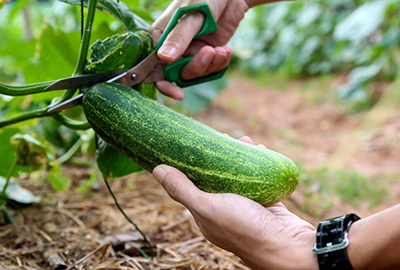
Harvesting Tips
Both slicers and picklers may be harvested and eaten fresh at any size.
Harvest often and while fruits are small to encourage new fruiting and abundant yields. A cucumber plant may stop producing new fruits while maturing existing fruits. Of greater concern is that after a cucumber plant has grown a few larger fruits, especially if the fruits are allowed to stay on the plant until they develop seeds, the plant may stop producing, decline, and die. If you allow the first few cucumber fruits to mature and develop seeds, that may be your entire harvest; whereas, if you harvest all fruits at smaller size, a cucumber plant may continue to produce for several weeks to a few months. GardenZeus recommends checking cucumber plants thoroughly about every other day while they are actively producing. Push leaves aside to look closely among stems, as missing even 1 or 2 fruits that grow to full size without your knowledge may reduce long-term yield from that plant.
When fruits of green or white varieties reach the stage of turning yellow (as opposed to inherently yellow varieties like Lemon cucumber), this usually means that cucumbers are overripe and likely to be bitter. If cucumber fruits grow too large, the skins and flesh may also toughen and the fruits may develop seeds. Be sure to remove overmature cucumber fruits as soon as you notice them, even if you do not plan to eat them.
During hot weather, harvest cucumber fruits as early in the morning as possible for maximum crispness.